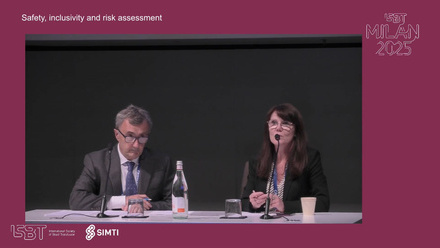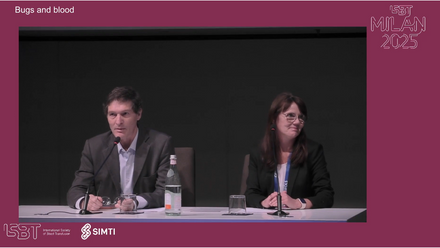The Epidemiology goes viral session included the following presentations:
1. Laura Tonnetti: The Impact of Babesia Testing on Transfusion-transmitted Babesiosis
2. Wen-Jie Liu: Ten-year experience of mini-pool nucleic acid testing in blood donors in Taiwan
3. Brian Custer: Prevalence, Incidence, and Residual Risk of HIV, HBV, and HCV in the US Blood Supply 2015 – 2021, on Behalf of the US TTIMS Program
4. Eduard Grebe: HIV incidence in US first-time blood donors during 12-month and 3-month MSM deferral policy periods on behalf of the US TTIMS Program
5. Daniel Candotti: Ten years insight into HBV molecular epidemiology in infected blood donors in Dalian, Northeast China
MODERATORS: Dudi Levi, Dorte Holm
After the presentation, there was a questions and answers session, which is also included in the recording.
Abstract
Ten-year experience of mini-pool nucleic acid testing in blood donors in Taiwan
W Liu1, C Yu1, Y Chen1, J Chen1, S Wei1, S Hou1,2
1Research, Taiwan Blood Services Foundation, 2Shin Kong Wu Ho-Su Memorial Hospital, Taipei, Taiwan, Republic of China
Background: Both mini-pool (MP) and individual donor (ID) nucleic acid tests (NAT) are widely used in detecting donor infection. Even though MP-NAT is less sensitive than ID-NAT, the testing cost of MP-NAT would be significantly lower and affordable by many blood collection centres. A universal NAT screening has been implemented in blood donors since 2013.
Aims: To determine the risk of transfusion-transmitted infection (TTI) for the human immunodeficiency virus (HIV), hepatitis C virus (HCV), and hepatitis B virus (HBV) and to investigate the suspected TTIs during 10-year MP-NAT screening.
Methods: All donations were tested for triplex NAT for HIV, HCV, and HBV in pools of eight donations using the Procleix Ultrio Plus Assay or Procleix Ultrio Elite Assay. Positive individual donations were resolved from the positive pools and confirmed by discriminatory assays of HIV, HCV and HBV. Each donation was also tested for anti-HIV, anti-HCV and HBsAg. Western blot was used as a confirmatory test for anti-HIV and anti-HCV, while HBsAg was confirmed by a neutralization test. The residual risk (RR) of window period TTI in blood donations was estimated according to the World Health Organization guideline. Investigation of HIV TTI was conducted by Taiwan Centers for Disease Control (TCDC). Every HIV case was scrutinized for blood donation history, and the associated recipients were investigated. Donors associated with recipients who were suspected of HIV TTI would also be investigated. An expert committee has been established since 2015 to determine the immutability of HCV and HBV TTI for each suspected case according to their laboratory tests before and after transfusion, procedures received and the associated blood donors’ follow-up testing results. If the donor does not return or has a positive result in a subsequent donation, the donors’ and recipients’ index blood specimens will be re-examined by TCDC.
Results: A total of 450 HIV, 3118 HCV and 20,009 HBV NAT-positive donations were detected in 17,855,971 donations collected from Jan 15, 2013 to Dec 31, 2022. The number of NAT yield donations were 12, 83, and 4236 for HIV, HCV, and HBV; the yield rates (95% CI) per 105 were 0.07 (0.04–0.12), 0.46 (0.37–0.58), and 23.72 (23.02–24.45). The overall NAT yield rates (95% CI) of HCV and HBV significantly declined, which decreased from 1.30 (0.85–1.97) and 33.45 (30.81–36.32) per 105 in 2013 to 0.21 (0.08–0.57) and 17.77 (15.96–19.78) per 105 in 2022 (both p for trend < 0.05). These rates were 1.5 to 5.7-fold in first-time donors than in repeat donors. Male donors had higher HIV (p = 0.07) and HBV NAT (p < 0.05) yield rates than female donors. The HCV (p = 0.07) and HBV NAT (p < 0.05) yield rates both increased with age. In contrast, donors younger than 30 had the highest HIV NAT yield rate (p = 0.01). The estimated RRs (95% CI) were 1.05 (0.90–1.23), 8.98 (8.22–9.82), and 49.17 (46.98–51.46) per million donations for HIV, HCV, and HBV in the case without NAT, and decreased to 0.35 (0.30–0.41), 0.75 (0.68–0.82), and 31.61 (30.20–33.08) after NAT. A total of 3902 HIV cases who had donated blood and their associated recipients were actively investigated, and no TTI case was identified. A total of 37 and 5 suspected HCV and HBV TTI cases subjected to review and none of their infections were associated with blood transfusion.
Summary/Conclusions: MP-NAT effectively detects infectious blood units in Taiwan, and no HIV, HCV, or HBV TTI case has been identified so far.





















